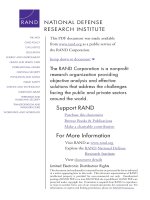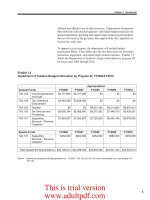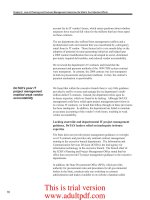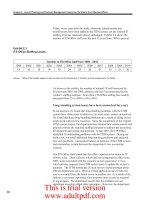Lecture Principle of inventory and material management - Lecture 12
Bạn đang xem bản rút gọn của tài liệu. Xem và tải ngay bản đầy đủ của tài liệu tại đây (763.84 KB, 52 trang )
Lecture 12
Capacity Management and Planning (continued)
Books
•
Introduction to Materials Management, Sixth Edition, J. R. Tony Arnold, P.E., CFPIM, CIRM, Fleming
College, Emeritus, Stephen N. Chapman, Ph.D., CFPIM, North Carolina State University, Lloyd M.
Clive, P.E., CFPIM, Fleming College
•
Operations Management for Competitive Advantage, 11th Edition, by Chase, Jacobs, and Aquilano, 2005,
N.Y.: McGrawHill/Irwin.
•
Operations Management, 11/E, Jay Heizer, Texas Lutheran University, Barry Render, Graduate School of
Business, Rollins College, Prentice Hall
Objectives
•
•
•
•
•
•
•
Managing Demand
Tactics for managing demand
Approaches to capacity expansion
Breakeven analysis
Decision tree and capacity expansion
Net present value
Capacity planning issues
Managing Demand
þ
Demand exceeds capacity
Curtail demand by raising prices, scheduling
longer lead time
þ
Long term solution is to increase capacity
þ
þ
Capacity exceeds demand
Stimulate market
þ
Product changes
þ
þ
Adjusting to seasonal demands
þ
Produce products with complementary
demand patterns
Tactics for Matching Capacity to Demand
1.
2.
Making staffing changes
Adjusting equipment
þ
þ
3.
4.
5.
6.
Purchasing additional machinery
Selling or leasing out existing equipment
Improving processes to increase throughput
Redesigning products to facilitate more throughput
Adding process flexibility to meet changing product
preferences
Closing facilities
Demand and Capacity Management in the Service Sector
þ
þ
Demand management
þ Appointment, reservations, FCFS rule
Capacity
management
þ Full time,
temporary,
parttime
staff
Approaches to Capacity Expansion
Demand
(c)
Leading demand
with incremental
expansion
New
capacity
Leading
demand with onestep
New expansion
Capacity lags demand
with incremental expansion
Expected
demand
Demand
capacity
Expected
demand
New
capacity
(b)
(d)
Expected
demand
Attempts to have an
average capacity with
incremental expansion
New
capacity
Demand
Demand
(a)
Expected
demand
Approaches to Capacity Expansion
(a)
Leading demand with incremental
expansion
Demand
New
capacity
Expected
demand
1
2
3
Time (years)
Approaches to Capacity Expansion
(b)
Leading demand with one-step
expansion
New
capacity
Demand
Expected
demand
1
2
3
Time (years)
Approaches to Capacity Expansion
Capacity lags demand with
incremental expansion
New
capacity
Expected
demand
Demand
(c)
1
2
3
Time (years)
Approaches to Capacity Expansion
Attempts to have an average capacity
with incremental expansion
New
capacity
Expected
demand
Demand
(d)
1
2
3
Time (years)
BreakEven Analysis
þ
þ
þ
Technique for evaluating process
and equipment alternatives
Objective is to find the point in
dollars and units at which cost
equals revenue
Requires estimation of fixed costs,
variable costs, and revenue
BreakEven Analysis
þ
Fixed costs are costs that continue
even if no units are produced
þ
þ
Depreciation, taxes, debt, mortgage
payments
Variable costs are costs that vary
with the volume of units produced
þ
þ
Labor, materials, portion of utilities
Contribution is the difference between
selling price and variable cost
BreakEven Analysis
Assumptions
þ
Costs and revenue are linear
functions
þ
þ
We actually know these costs
þ
þ
Generally not the case in the real
world
Very difficult to accomplish
There is no time value of money
BreakEven Analysis
–
Total revenue line
900 –
800 –
Cost in dollars
Break-even point
cost = Total revenue
700 Total
–
t
ofi
r
P
or
d
i
r
r
co
Total cost line
600 –
500 –
400 –
300 –
s s or
o
200L– rrid
co
100 –
|
Variable cost
Fixed cost
|
|
|
|
|
|
|
|
|
|
– |
0 100 200 300 400 500 600 700 800 900 1000 1100
Volume (units per period)
BreakEven Analysis
BEPx = breakeven point in units
BEP$ = breakeven point in dollars
P = price per
unit (after all discounts)
Breakeven point occurs when
TR = TC
or
Px = F + Vx
x = number of units
produced
TR = total revenue = Px
F = fixed costs
V = variable cost per
unit
TC = total costs = F +
Vx
F
BEPx =
P-V
BreakEven Analysis
BEPx = breakeven point in units
BEP$ = breakeven point in dollars
P = price per
unit (after all discounts)
BEP$= BEPx P
F
=
P
P-V
F
=
(P - V)/P
F
=
1 - V/P
x = number of units
produced
TR = total revenue = Px
F = fixed costs
V = variable cost per
unit
TC = total costs = F +
Vx
Profit
= TR - TC
= Px - (F + Vx)
= Px - F - Vx
= (P - V)x - F
BreakEven Example
Fixed costs = $10,000
Direct labor = $1.50/unit
BEP$ =
F
1 - (V/P) =
Material = $.75/unit
Selling price = $4.00 per unit
$10,000
1 - [(1.50 + .75)/(4.00)]
BreakEven Example
Fixed costs = $10,000
Direct labor = $1.50/unit
BEP$ =
F
1 - (V/P) =
$10,000
= .4375
F
BEPxP=- V
Material = $.75/unit
Selling price = $4.00 per unit
$10,000
1 - [(1.50 + .75)/(4.00)]
= $22,857.14
=
$10,000
4.00 - (1.50 + .75)= 5,714
BreakEven Example
50,000 –
Revenue
40,000 –
Break-even
point
Dollars
30,000 –
Total
costs
20,000 –
10,000 –
Fixed costs
–
|
|
|
0
2,000
4,000
|
6,000
Units
|
|
8,000
10,000
BreakEven Example
Multiproduct Case
BEP$ =
∑
where
V
P
F
W
i
1-
F
Vi
Pi
x (Wi)
= variable cost per unit
= price per unit
= fixed costs
= percent each product is of total dollar sales
= each product
Multiproduct Example
Fixed costs = $3,500 per month
Item
Sandwich
Soft drink
Baked potato
Tea
Salad bar
Price
$2.95
.80
1.55
.75
2.85
Cost
$1.25
.30
.47
.25
1.00
Annual Forecasted
Sales Units
7,000
7,000
5,000
5,000
3,000
Multiproduct Example
Fixed costs = $3,500 per month
Annual Forecasted
Item
Price
Cost
Sales Units
Sandwich
$2.95
$1.25
7,000
Soft drink
.80
.30
7,000
Annual
Weighted
Baked
potato
1.55
.47
5,000
Selling Variable
Forecasted % of Contribution
Item (i)
Tea Price (P) Cost (V) (V/P)
.75 1 - (V/P)
.25 Sales $ Sales
5,000 (col 5 x col 7)
Salad$2.95
bar
1.00 $20,650
3,000
Sandwich
$1.25 2.85
.42
.58
.446
.259
Soft drink
Baked
potato
Tea
Salad bar
.80
1.55
.30
.47
.38
.30
.62
.70
5,600
7,750
.121
.167
.075
.117
.75
2.85
.25
1.00
.33
.35
.67
.65
3,750
8,550
$46,300
.081
.185
1.000
.054
.120
.625
F
Multiproduct Example
BEP$ =
∑
1-
Fixed costs = $3,500 per month
Vi
x (Wi)
Pi
$3,500
x 12
Annual
Forecasted
= $67,200
.625
Item
Price
Cost
Sales Units
Sandwich
$2.95
$1.25
7,000
Daily
Soft drink
.80
.30 = $67,200
7,000
= $215.38
salesAnnual
312 days
Weighted
Baked
potato
1.55
.47
5,000
Selling Variable
Forecasted % of Contribution
Item (i)
Tea Price (P) Cost (V) (V/P)
.75 1 - (V/P)
.25 Sales $ Sales
5,000 (col 5 x col 7)
.446 x $215.38
= 32.6 .259
33
Salad
bar
2.85
1.00
3,000
Sandwich
$2.95
$1.25
.42
.58
$20,650
.446
$2.95
sandwiches
=
Soft drink
Baked
potato
Tea
Salad bar
.80
1.55
.30
.47
.38
.30
.62
.70
5,600
7,750
.75
2.85
.25
1.00
.33
.35
.67
.65
3,750
8,550
$46,300
.121
.075
.167 per day
.117
.081
.185
1.000
.054
.120
.625
Decision Trees and Capacity Decision
Market favorable (.4)
nt
a
l
ep
g
r
La
Market unfavorable (.6)
Market favorable (.4)
Medium plant
Sm
all
p
Market unfavorable (.6)
lan
Do
$100,000
-$90,000
$60,000
-$10,000
t
no
th
ing
Market favorable (.4)
Market unfavorable (.6)
$40,000
-$5,000
$0
Decision Trees and Capacity Decision
Market favorable (.4)
nt
a
l
ep
g
r
La
Market unfavorable (.6)
Market favorable (.4)
Medium plant
Sm Large Plant
all
p la
nt
EMV = (.4)($100,000)
Do
no
+ (.6)(-$90,000)
th
ing
EMV = -$14,000
Market unfavorable (.6)
Market favorable (.4)
Market unfavorable (.6)
$100,000
-$90,000
$60,000
-$10,000
$40,000
-$5,000
$0









